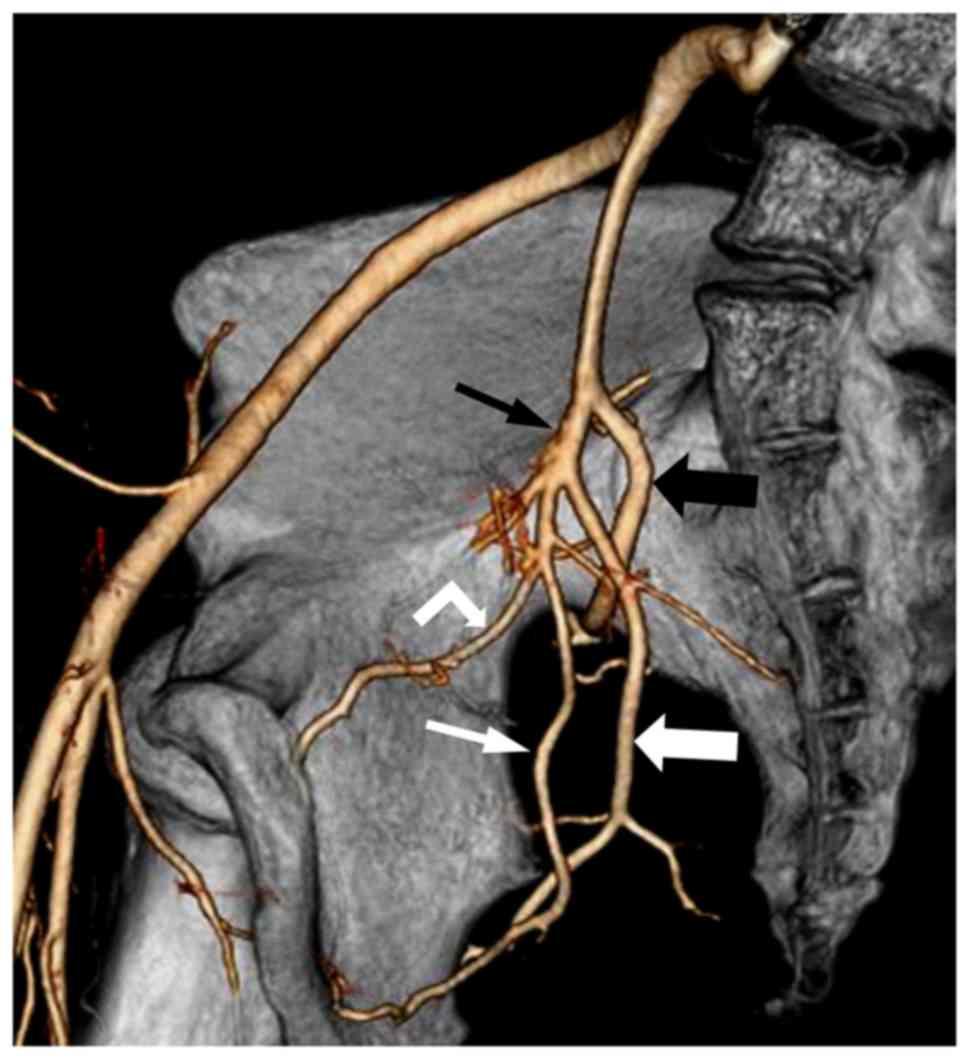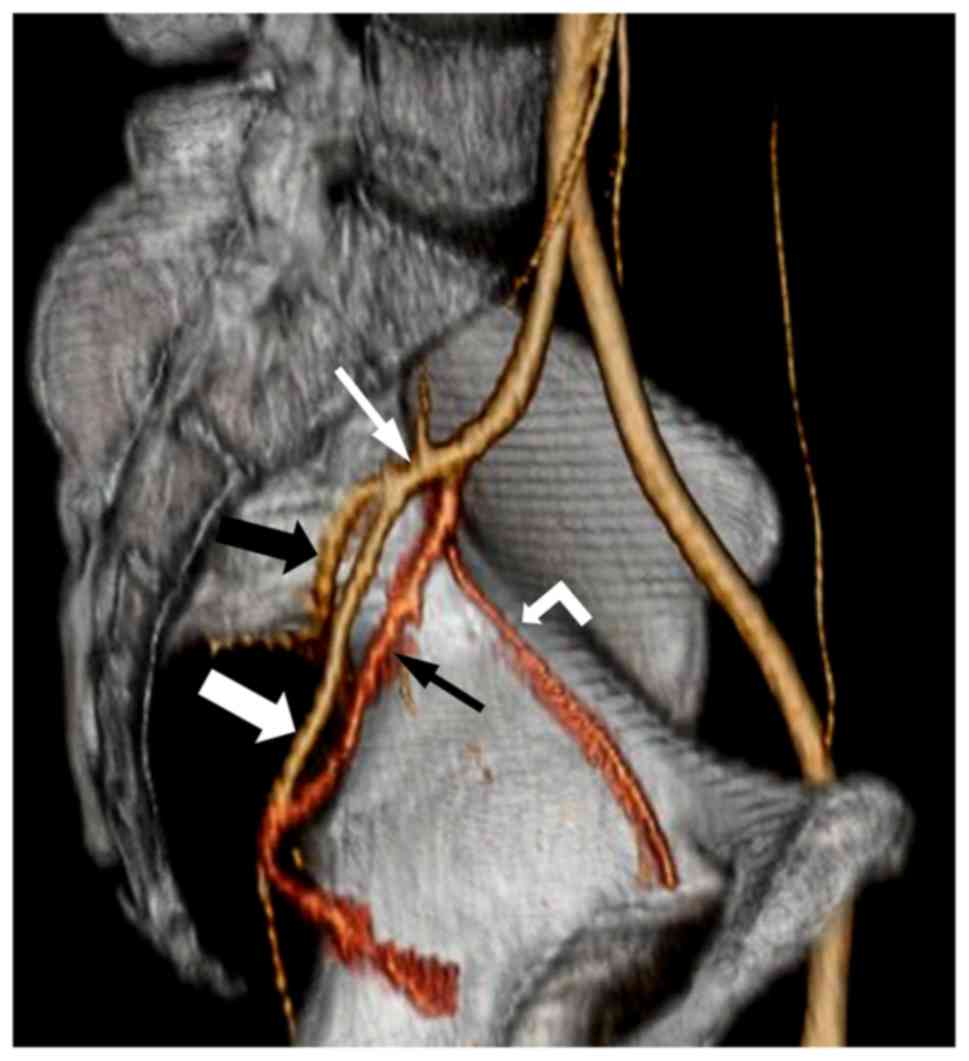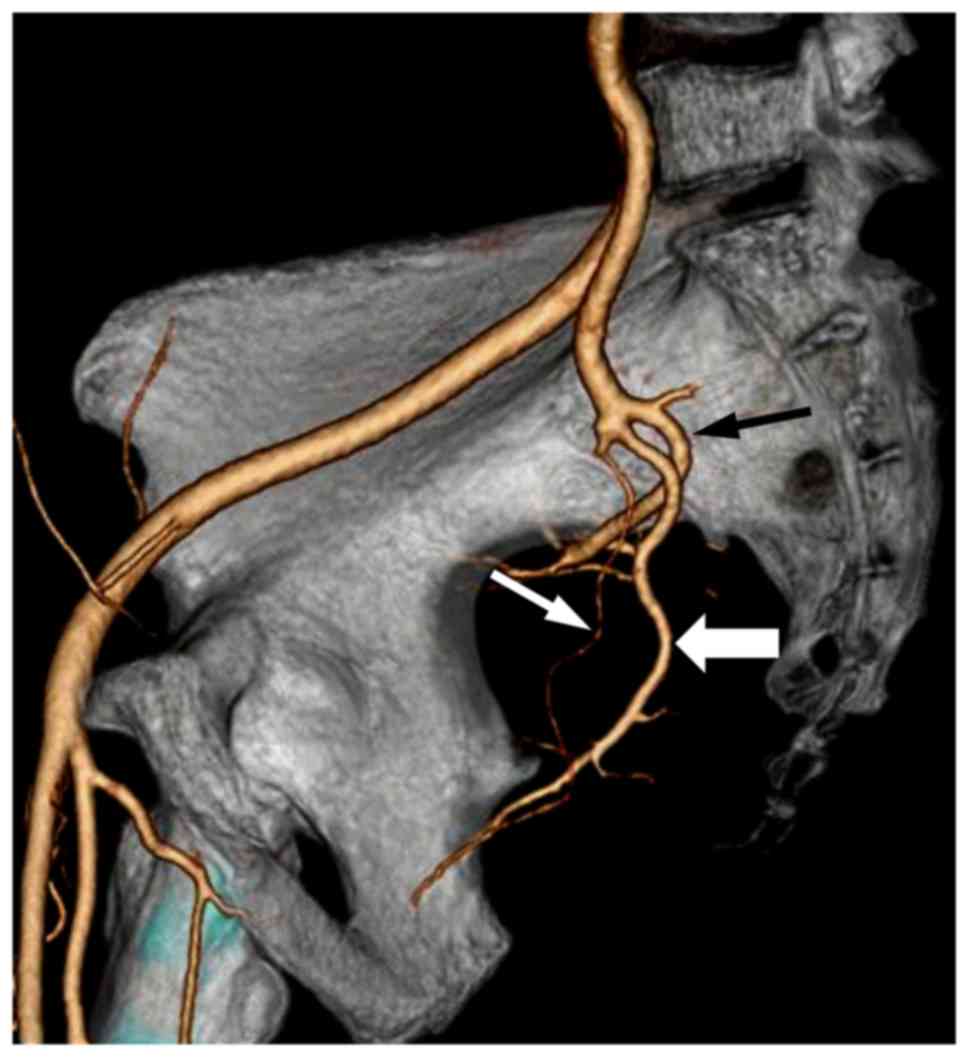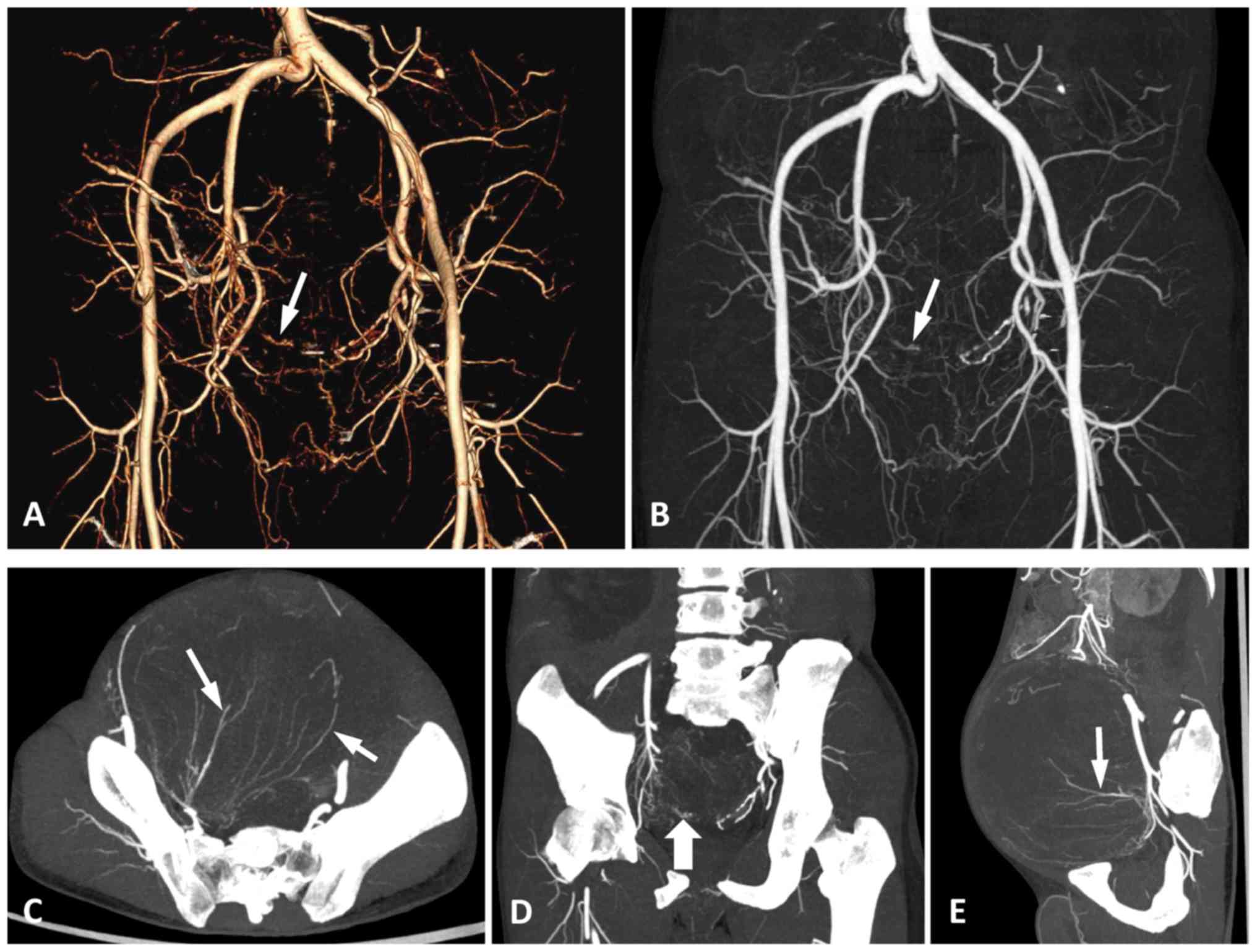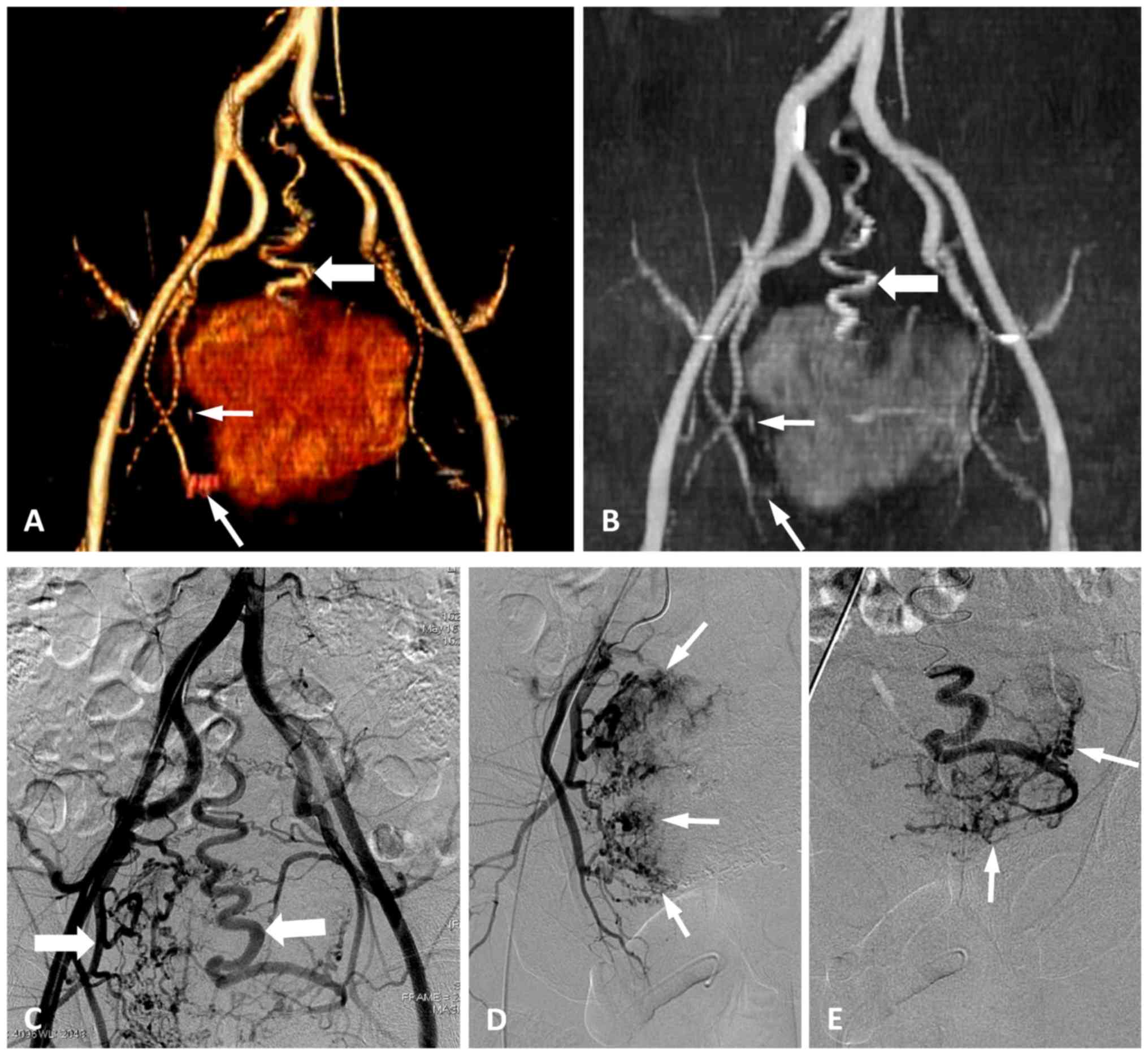|
1
|
Ding HM, Yin ZX, Zhou XB, Li YB, Tang ML,
Chen SH, Xu DC and Zhong SZ: Three-dimensional visualization of
pelvic vascularity. Surg Radiol Anat. 30:437–442. 2008. View Article : Google Scholar : PubMed/NCBI
|
|
2
|
Levy AD, Manning MA, Al-Refaie WB and
Miettinen MM: Soft-tissue sarcomas of the abdomen and pelvis:
Radiologic-pathologic features, part 1-common sarcomas: From the
radiologic pathology archives. Radiographics. 37:462–483. 2017.
View Article : Google Scholar : PubMed/NCBI
|
|
3
|
Bilhim T, Casal D, Furtado A, Pais D,
O'Neill JE and Pisco JM: Branching patterns of the male internal
iliac artery: Imaging findings. Surg Radiol Anat. 33:151–159. 2011.
View Article : Google Scholar : PubMed/NCBI
|
|
4
|
Chantalat E, Merigot O, Chaynes P, Lauwers
F, Delchier MC and Rimailho J: Radiological anatomical study of the
origin of the uterine artery. Surg Radiol Anat. 36:1093–1099. 2014.
View Article : Google Scholar : PubMed/NCBI
|
|
5
|
Naguib NN, Nour-Eldin NE, Hammerstingl RM,
Lehnert T, Floeter J, Zangos S and Vogl TJ: Three-dimensional
reconstructed contrast-enhanced MR angiography for internal iliac
artery branch visualization before uterine artery embolization. J
Vasc Interv Radiol. 19:1569–1575. 2008. View Article : Google Scholar : PubMed/NCBI
|
|
6
|
Selvaraj L and Sundaramurthi I: Study of
normal branching pattern of the coeliac trunk and its variations
using CT angiography. J Clin Diagn Res. 9:AC01–AC04.
2015.PubMed/NCBI
|
|
7
|
Yamaki K, Saga T, Doi Y, Aida K and
Yoshizuka M: A statistical study of the branching of the human
internal iliac artery. Kurume Med J. 45:333–340. 1998. View Article : Google Scholar : PubMed/NCBI
|
|
8
|
Sakthivelavan S, Aristotle S, Sivanandan
A, Sendiladibban S and Felicia Jebakani C: Variability in the
branching pattern of the internal iliac artery in Indian population
and its clinical importance. Anat Res Int.
2014:5971032014.PubMed/NCBI
|
|
9
|
Bilhim T, Pereira JA, Fernandes L, Rio
Tinto H and Pisco JM: Angiographic anatomy of the male pelvic
arteries. AJR Am J Roentgenol. 203:W373–W382. 2014. View Article : Google Scholar : PubMed/NCBI
|
|
10
|
Mori K, Saida T, Shibuya Y, Takahashi N,
Shiigai M, Osada K, Tanaka N and Minami M: Assessment of uterine
and ovarian arteries before uterine artery embolization: Advantages
conferred by unenhanced MR angiography. Radiology. 255:467–475.
2010. View Article : Google Scholar : PubMed/NCBI
|
|
11
|
Rott G and Boecker F: The extremely rare
vascular variant of a segmental duplicated uterine artery and its
relevance for the interventionist and gynecologist: A case report.
J Med Case Rep. 10:1622016. View Article : Google Scholar : PubMed/NCBI
|
|
12
|
de Assis AM, Moreira AM, de Paula
Rodrigues VC, Harward SH, Antunes AA, Srougi M and Carnevale FC:
Pelvic arterial anatomy relevant to prostatic artery embolisation
and proposal for angiographic classification. Cardiovasc Intervent
Radiol. 38:855–861. 2015. View Article : Google Scholar : PubMed/NCBI
|
|
13
|
Bilhim T, Pisco JM, Rio Tinto H, Fernandes
L, Pinheiro LC, Furtado A, Casal D, Duarte M, Pereira J, Oliveira
AG and O'Neill JE: Prostatic arterial supply: Anatomic and imaging
findings relevant for selective arterial embolization. J Vasc
Interv Radiol. 23:1403–1415. 2012. View Article : Google Scholar : PubMed/NCBI
|
|
14
|
Hu HJ, Huang YW and Zhu YC: Tumor feeding
artery reconstruction with multislice spiral CT in the diagnosis of
pelvic tumors of unknown origin. Diagn Interv Radiol. 20:9–16.
2014.PubMed/NCBI
|
|
15
|
Wang MQ, Duan F, Yuan K, Zhang GD, Yan J
and Wang Y: Benign prostatic hyperplasia: Cone-beam CT in
conjunction with DSA for identifying prostatic arterial anatomy.
Radiology. 282:271–280. 2017. View Article : Google Scholar : PubMed/NCBI
|
|
16
|
Lee JH, Jeong YK, Park JK and Hwang JC:
‘Ovarian vascular pedicle’ sign revealing organ of origin of a
pelvic mass lesion on helical CT. AJR Am J Roentgenol. 181:131–137.
2003. View Article : Google Scholar : PubMed/NCBI
|
|
17
|
Ota H, Takase K, Igarashi K, Chiba Y, Haga
K, Saito H and Takahashi S: MDCT compared with digital subtraction
angiography for assessment of lower extremity arterial occlusive
disease: Importance of reviewing cross-sectional images. AJR Am J
Roentgenol. 182:201–209. 2004. View Article : Google Scholar : PubMed/NCBI
|
|
18
|
Duffis EJ, Jethwa P, Gupta G, Bonello K,
Gandhi CD and Prestigiacomo CJ: Accuracy of computed tomographic
angiography compared to digital subtraction angiography in the
diagnosis of intracranial stenosis and its impact on clinical
decision-making. J Stroke Cerebrovasc Dis. 22:1013–1017. 2013.
View Article : Google Scholar : PubMed/NCBI
|
|
19
|
Danias PG, McConnell MV, Khasgiwala VC,
Chuang ML, Edelman RR and Manning WJ: Prospective navigator
correction of image position for coronary MR angiography.
Radiology. 203:733–736. 1997. View Article : Google Scholar : PubMed/NCBI
|
|
20
|
Pfeil A, Betge S, Poehlmann G, Boettcher
J, Drescher R, Malich A, Wolf G, Mentzel HJ and Hansch A: Magnetic
resonance VIBE venography using the blood pool contrast agent
gadofosveset trisodium-An interrater reliability study. Eur J
Radiol. 81:547–552. 2012. View Article : Google Scholar : PubMed/NCBI
|
|
21
|
Landis JR and Koch GG: The measurement of
observer agreement for categorical data. Biometrics. 33:159–174.
1977. View
Article : Google Scholar : PubMed/NCBI
|
|
22
|
Farghadani M, Momeni M, Hekmatnia A,
Momeni F and Baradaran Mahdavi MM: Anatomical variation of celiac
axis, superior mesenteric artery, and hepatic artery: Evaluation
with multidetector computed tomography angiography. J Res Med Sci.
21:1292016. View Article : Google Scholar : PubMed/NCBI
|
|
23
|
Schernthaner R, Stadler A, Lomoschitz F,
Weber M, Fleischmann D, Lammer J and Loewe Ch: Multidetector CT
angiography in the assessment of peripheral arterial occlusive
disease: Accuracy in detecting the severity, number, and length of
stenoses. Eur Radiol. 18:665–671. 2008. View Article : Google Scholar : PubMed/NCBI
|
|
24
|
Delgado Almandoz JE, Romero JM, Pomerantz
SR and Lev MH: Computed tomography angiography of the carotid and
cerebral circulation. Radiol Clin North Am. 48:265–281. 2010.
View Article : Google Scholar : PubMed/NCBI
|
|
25
|
Fang JF, Shih LY, Wong YC, Lin BC and Hsu
YP: Repeat transcatheter arterial embolization for the management
of pelvic arterial hemorrhage. J Trauma. 66:429–435. 2009.
View Article : Google Scholar : PubMed/NCBI
|
|
26
|
Salehi M, Jalilian N, Salehi A and Ayazi
M: Clinical efficacy and complications of uterine artery
embolization in symptomatic uterine fibroids. Glob J Health Sci.
8:245–250. 2015. View Article : Google Scholar : PubMed/NCBI
|
|
27
|
Zhang E, Liu L and Owen R: Pelvic artery
embolization in the management of obstetrical hemorrhage:
Predictive factors for clinical outcomes. Cardiovasc Intervent
Radiol. 38:1477–1486. 2015. View Article : Google Scholar : PubMed/NCBI
|
|
28
|
de Assis AM, Moreira AM, de Paula
Rodrigues VC, Yoshinaga EM, Antunes AA, Harward SH, Srougi M and
Carnevale FC: Prostatic artery embolization for treatment of benign
prostatic hyperplasia in patients with prostates >90 g: A
prospective single-center study. J Vasc Interv Radiol. 26:87–93.
2015. View Article : Google Scholar : PubMed/NCBI
|
|
29
|
Al-Thunyan A, Al-Meshal O, Al-Hussainan H,
Al-Qahtani MH, El-Sayed AA and Al-Qattan MM: Buttock necrosis and
paraplegia after bilateral internal iliac artery embolization for
postpartum hemorrhage. Obstet Gynecol. 120:468–470. 2012.
View Article : Google Scholar : PubMed/NCBI
|



